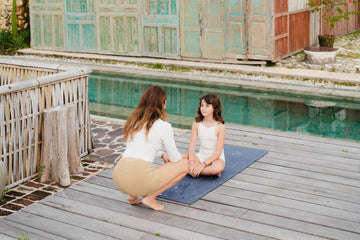As parents, we all strive to nurture our children's physical, mental, and emotional well-being. In today's fast-paced world, where stress and overstimulation seem to be constants, it's more important than ever to equip our little ones with tools to help them navigate life with balance and resilience.
One such tool that holds incredible potential is the practice of yoga! Yoga is not just a form of physical exercise; it's a holistic discipline that can cultivate mindfulness, strength, flexibility, and emotional awareness in both children and adults.

You may be wondering how to introduce your child to yoga in a way that is engaging, educational, and, most importantly, enjoyable. The key lies in creating an environment that is conducive to learning and exploration. Here are some expert tips on how to set the stage for your child's yoga journey, making it playful, brief, and calming.
- Setting the Tone: Before diving into the physical practice of yoga, it's important to establish a positive and inviting atmosphere. Find a quiet, clutter-free space in your home where you and your child can practice without distractions. Consider dimming the lights, playing soft music, or lighting a scented candle to create a calming ambiance. Encourage your child to approach the practice with an open mind and a sense of curiosity.

- Making It Playful: Children are naturally curious and love to play. Infuse elements of playfulness into your yoga sessions to keep your child engaged and excited. Incorporate animal-inspired poses like Cat-Cow, Downward Dog, and Cobra to make the practice more relatable and fun. Use story-telling and imaginative play to weave a narrative throughout the practice, allowing your child to explore different movements and shapes in a creative way.

3. Kid-Friendly Props: Bring in some colorful yoga mats, props, and accessories that resonate with your child's imagination. Our vibrant and eco-friendly mats at Yoga Design Lab are perfect for creating a whimsical yoga space!
4. Keeping It Short: Children have short attention spans, so it's important to keep your yoga sessions brief and focused. Aim for short, 10 to 15-minute sessions to begin with, gradually increasing the duration as your child becomes more comfortable with the practice. Use visual cues like a timer or a musical chime to signal the beginning and end of each session, providing structure and predictability.

5. Time to Relax: Just as important as the active poses in yoga are moments of stillness and relaxation. Introduce your child to simple breathing exercises and guided meditations to help them calm their minds and connect with their inner selves. Encourage them to lie down on a soft, kid-friendly yoga mat, like those from Yoga Design Lab's collection, designed with vibrant colors and patterns to spark their imagination and creativity.
By following these expert tips and infusing your child's yoga practice with joy, creativity, and relaxation, you can help them cultivate a lifelong love for this ancient discipline. Remember, the goal is not perfection but progress. Celebrate your child's efforts and achievements, no matter how small, and watch as they blossom into mindful, balanced individuals ready to face life's challenges with grace and resilience.
By, Alexis Miller, RYT




